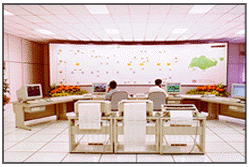| Expansion After Independence |
| |
|
|
The Public Utilities Board was
inaugurated on 1 May 1963 to
take over the responsibility of providing electricity, water and piped gas from the former
City Council.
Over the last 3 decades, several major water supply projects were undertaken by the Board to
develop new water resources
to support Singapore’s rapid housing and industrialisation programmes. |
| |
In Johor,
the Scudai River Scheme and Johor River Scheme were completed in the mid 1960s. Both
schemes consist of a river
intake and treatment plant
and a pumping station. A pipeline was laid from Johor River Waterworks to
convey treated water to
Singapore.
In 1975, two major water supply
schemes were completed. The
first was the Upper Peirce Scheme which entailed the construction of a dam at the upper reaches of the old Peirce Reservoir (which
was renamed Lower Peirce
Reservoir). |
The second was the Kranji/Pandan Scheme which comprised Kranji Reservoir, created by
damming the estuary of Kranji
River, and Pandan Reservoir, by building a dyke to enclose a mangrove swamp. Another major scheme, the Western
Catchments Scheme was
completed in 1981. Four rivers - Murai, Poyan, Sarimbun and Tengeh were dammed and converted into
reservoirs.
In
1986, the Sungei Seletar/Bedok Water Scheme was completed. The scheme
involved the damming of Sungei Seletar to form a reservoir (Lower
Seletar Reservoir), creation
of Bedok Reservoir from a former sand quarry and construction of Bedok
Waterworks. Its unique feature was the construction of
nine stormwater collection stations to tap the storm runoffs of the surrounding urbanised catchments. Eight of these
collection stations are ponds at Yishun, Tampines, Bedok and Yan Kit new
towns.
In the
1980s, the treatment capacities of Scudai Waterworks and Johor River
Waterworks were extended. A pipeline from Johor River Waterworks to
Singapore, across the Straits of Johor, was also completed. |
| |
| In 1988,
work commenced on the Linggiu Reservoir project in Johor. This project,
which involved the
construction of a dam across Sungei Linggiu, a tributary of the Johor
River, and other saddle embankments and ancillary works was completed in
1993. In conjunction with the Linggiu project, another pipeline was laid
to convey water from Johor River Waterworks to Singapore. |
| |
|
| To enhance the
operational efficiency and reliability of the treatment and distribution
of water, the waterworks, pumping stations and service reservoirs in
Singapore, are remotely monitored and controlled from a System Control
Centre. |

 Woodleigh System Control Centre. Woodleigh System Control Centre.
|